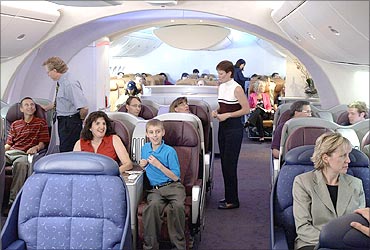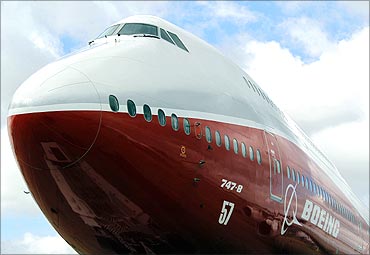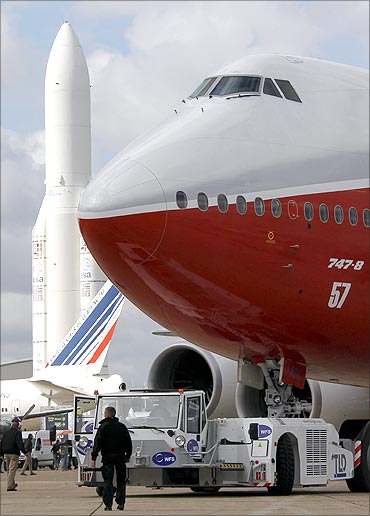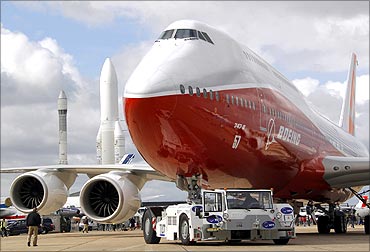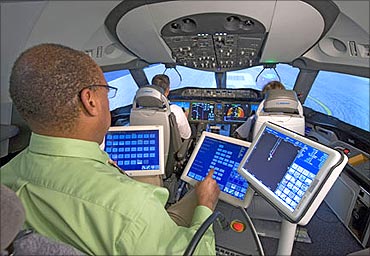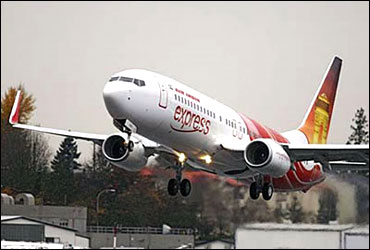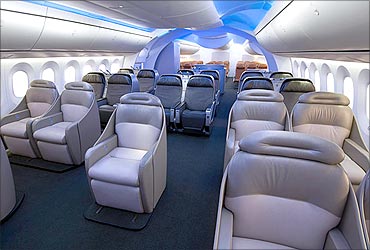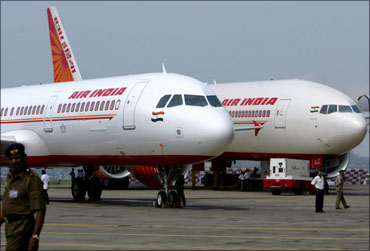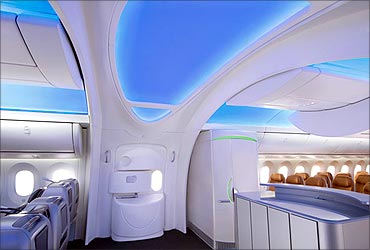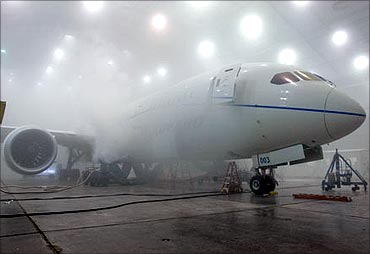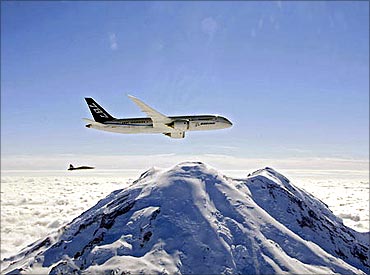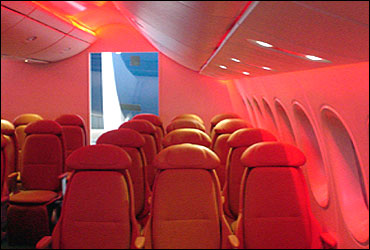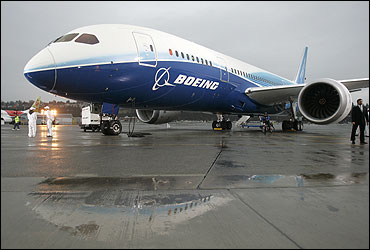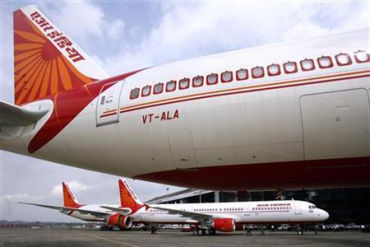 | « Back to article | Print this article |
Can the Dreamliner save Air India?
On 13th July, Boeing's much delayed Dreamliner 787 will touch down on a Delhi tarmac on the way back to its headquarters in Seattle. For Boeing, Air India (AI) is just one of its 56 odd customers who have ordered this hi-tech aircraft, and the solo test flight from Delhi to Seattle via Mumbai is primarily meant to demonstrate the technological edge of this new bird in the sky to its customer.
Click NEXT to read on
Can the Dreamliner save Air India?
It is hoping that the plane will become the most potent weapon in its arsenal to fight itself out of its current twin nightmares - an eroding market share in the international skies and its current financial mess.
Come October, Air India will get its first 259-seater Dreamliner (with 18 business class seats) - a delay of over three years from the original schedule - with three more aircraft being dropped off this year.
Click NEXT to read on
Can the Dreamliner save Air India?
Seven more planes will join the fleet next year. Air India, which has ordered 27 of these newly designed aircraft, will use them on its middle-haul flights ( up to eight and a half hours)- a key focus of its business-replacing the long-haul 777 and the short -haul A-320 which currently run on these routes to other destinations.
Air India is gambling heavily on the Dreamliner to reverse its fortunes.
Click NEXT to read on
Can the Dreamliner save Air India?
By playing its Dreamliner card, Air India hopes to leap-frog its rivals in two key ways : it will have a brand new fleet on middle-haul routes with planes that are precisely suited for that type of journey compared to others of atleast two to three years Indian rivals who are still saddled with older aircraft.
Plus, they get a head-start over their competitors in India as Jet Airways, which has also ordered the same aircraft, has to wait in the wings till 2014 for deliveries.
Click NEXT to read on
Can the Dreamliner save Air India?
The main problem that the national airline is confronted with today is a huge mismatch between the kind of aircrafts it uses and the sectors it places them in, resulting in a much higher cost per revenue kilometre than its competitors, thereby requiring a higher passenger load factor to break even.
For instance, AI has deployed long-haul aircraft Boeing 777 on middle haul routes which include flying to Tokyo, London, Seoul and Shanghai.
Click NEXT to read on
Can the Dreamliner save Air India?
The 777 is typically a long- haul aircraft optimised for flights of over 15 hours, and is about 112 tonnes heavier than a Dreamliner, guzzles more fuel and therefore simply unsuitable for flying middle-haul routes.
Click NEXT to read on
Can the Dreamliner save Air India?
AI executives say that it would cost them 25 per cent less per revenue kilometres if the 777 were to be replaced by the 787 on these routes.
Many analysts also say that the airline was not quick enough, unlike its more nimble-footed competitors , to lease out A-330's-which have similar seating and fuel efficiencies to the 787-in the interim period till its 787 deliveries came in.
Click NEXT to read on
Can the Dreamliner save Air India?
The mismatch between Air India's aircrafts and routes seems to have had a snowballed within the airline.
AI is also deploying aircraft meant for short-hauls on middle-haul routes in south East Asia as well as West Asia.
So, once again, it is using an unsuitable, short-haul plane, the A-319, to fly the Delhi-Singapore middle-haul leg with only 100 seats on board because it has to reduce seats for all that extra fuel it needs for the longer distance.
Click NEXT to read on
Can the Dreamliner save Air India?
All of this makes competing with Indian rivals like Jet Airways, which flies the more economical A 330, that much more difficult.
AI admits that their operational cost per revenue kilometres is at least 50 per cent higher and this renders it impossible for them to make money.
Which is why the company is betting big on the Dreamliner, stating that 47 per cent of the additional capacity will come from its new fleet of 787s.
Click NEXT to read on
Can the Dreamliner save Air India?
"And this will help us in becoming an Asian regional airline. It will also help us in putting the right type of aircraft in the appropriate sector," he says.
AI says that the airlines have over 63 A-320's out of which about 30 per cent is deployed in middle haul routes. The plan is to replace at least 25 per cent of the fleet from A-320 to Dreamliners.
Click NEXT to read on
Can the Dreamliner save Air India?
AI's connections to Europe in general are very limited for a global airline-it ties to London, Paris and Frankfurt only.
As a result the Indian market to Europe has been dominated by European carriers like Lufthansa and British Airways or KLM which call the shots.
Even its Indian competitors Jet Airways have created a strong base in Brussels from where it flies passengers to US, Canada and through their alliance all across Europe.
Click NEXT to read on
Can the Dreamliner save Air India?
But this could change with the Dreamliner and traffic experts are looking at the possibilities to fly directly in European cities like Brussels, Milan, Rome, Madrid and Barcelona to name a few.
Similarly, in markets like Thailand and Hong Kong, Air India has lost out market share to Jet Airways. Plus, AI used to fly Kuala Lumpur but does not now.
Click NEXT to read on
Can the Dreamliner save Air India?
AI expects that 80 per cent of its additional traffic growth will come from west Asia, south East Asia and Western Europe alone.
A more ambitious plan is to try and conquer hitherto untapped markets, thanks to its dream plane.
Click NEXT to read on
Can the Dreamliner save Air India?
Boeing's India president Dinesh Keskar says that AI can fly the Dreamliner non-stop to Melbourne from Delhi by reducing its cargo load as it is a nine and a half hour flight (carriers can redeye seats, take more fuel and fly a larger number of hours ).
AI is also thinking of linking up Chennai to Melbourne through a direct flight.
Click NEXT to read on
Can the Dreamliner save Air India?
And of course Australia, with its largest Indian student community, is a growing market. Naturally, the question here is whether AI will be able to fill up a plane which has a capacity of 259 seats.
The Dreamliner also ushers in new opportunities for AI. For instance, the Chinese market is not well connected-there is currently only one connection from India to Shanghai and none to Guangzhou.
Can the Dreamliner save Air India?
Executives at AI say that the African market has suddenly started to look promising considering the growing business linkages with the continent.
"However currently we do not cater to these markets directly, like Johannesburg or Nairobi amongst others. The Dreamliner can be deployed in there", says a senior AI executive.
Click NEXT to read on
Can the Dreamliner save Air India?
AI has already prepared plans for a separate cargo business and the new aircraft could of course play a key role in enhancing revenues.
These plans may sound strategically impressive but it is important to remember that AI is in a serious financial tailspin and that its management has already written to the PMO with a warning that it might be left with no option but to default on its interest payments on loans that were taken for the acquisition of aircraft which are guaranteed by the government for Rs 15,000 crore (Rs 150 billion).
Click NEXT to read on
Can the Dreamliner save Air India?
For AI the next few weeks are crucial as the government is expected to take a final decision on its turnaround plan and sanction it over Rs 6,000 crore (Rs 60 billion), which it requires as equity infusion, to bring the company back into a position for take-off.
But as the top bosses discuss its future, there is no doubt that the Dreamliner would be the linchpin of its survival strategy in the international skies.

